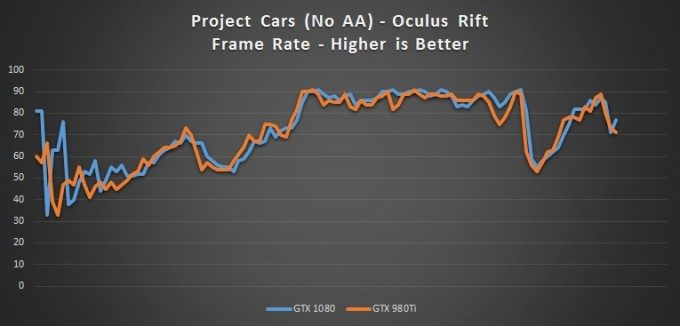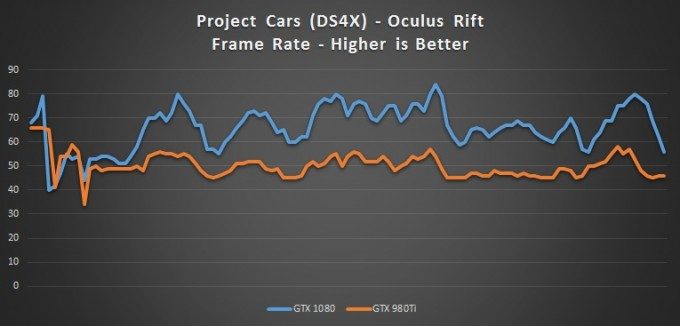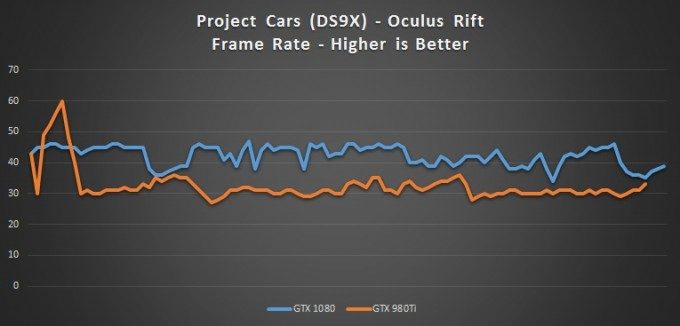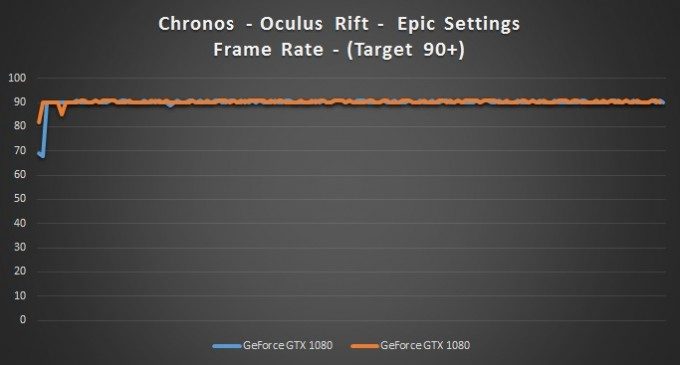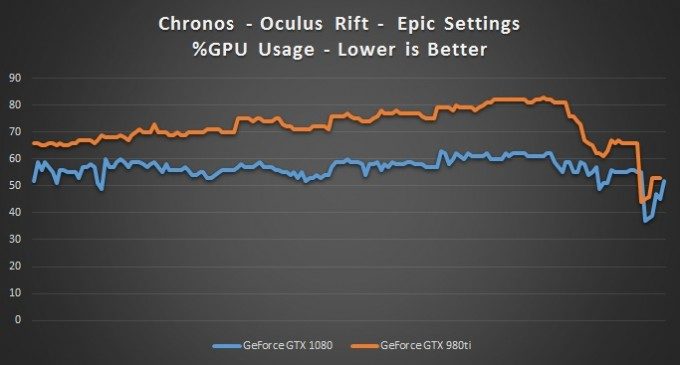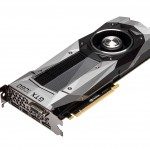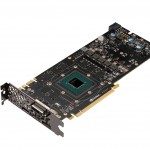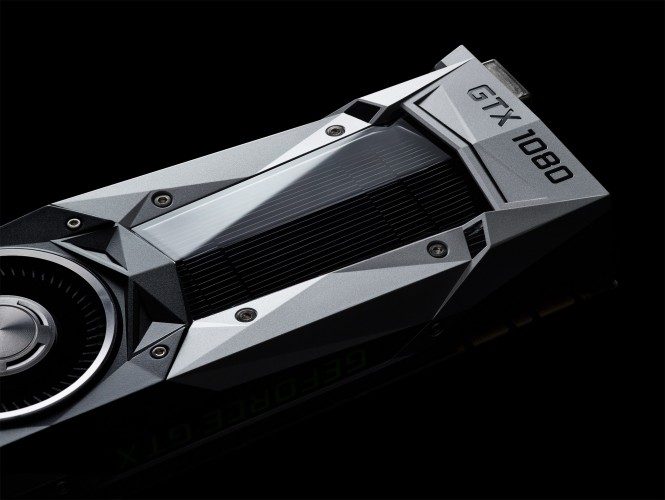Table of Contents
VR Gaming
So this is where it gets a little more tricky. Measuring performance on 2D applications is relatively straightforward, count the frames rendered in a fixed period of time using a fixed benchmarking scene, rinse and repeat. Here’s why that isn’t an option for VR.
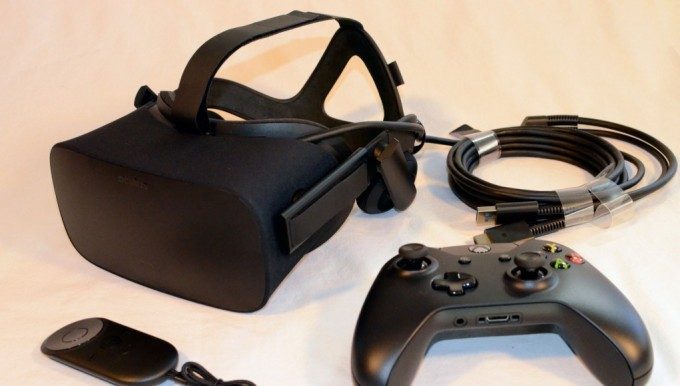
1) There are no VR specific synthetic (or otherwise) benchmarking applications (with one exception) dedicated to testing your system’s performance.

2) If you try to apply 2D gaming benchmarking methodologies directly to VR you’ll come unstuck. Desktop consumer VR systems clever rendering tricks to present a consistent display update. In the case of the Oculus Rift, the headset we chose to benchmark with here, the most problematic is Asynchronous Timewarp. This is a technology which aims to smooth out any lumps in rendering performance and resulting nausea for users by drawing any given frame using the most up to date position of the user’s head, interpolating the final image to match. So, even if your GPU is falling behind on consecutive frame updates, the user may not notice as they’re always presented with a view that their brain is expecting relative to their head’s movement. What this means is that any drops in frames as seen by benchmarking metrics gathering software may not result in an experiential issue for the user once inside VR.
Asynchronous timewarp (ATW) is a technique that generates intermediate frames in situations when the game can’t maintain frame rate, helping to reduce judder. However, ATW is not a silver bullet and has limitations that developers should be aware of.
Additionally, good VR applications are (very wisely) built from the ground up to prioritise frame rate over visual fidelity, to make sure that those on the lowest recommended hardware will still receive a smooth, nausea-free experience. That focus on stability of frame rate has meant that developers have been reticent to include the pages of graphics options and settings PC users are accustomed too – the last thing you need as a developer is another set of variables to test when the results may end up in people being sick.
The upshot of all of this is that both the GTX 980 Ti and GTX 1080 are supremely overqualified in terms of raw grunt to handle the majority of VR experiences out there. But, if you’re spending almost 600 dollars on a new GPU, you’ll want to know how much headroom the card will deliver and whether you can improve your VR experience in any way to take advantage of that extra power.
So, we chose to pick a handful of VR games and experiences which allow a level of visual tweaking, to levels that will make these cards sweat and deliver a visual experience that’s a cut above the norm. Each title was run with the headset sat in a fixed location in view of the Oculus sensor, angled to catch the lions share of the action. We then gathered metrics on GPU load and the resulting frame rate to see how well each card coped. For each settings level on each card, we also ran the same test wearing the headset to gauge the actual user experience to sanity check the (potentially problematic) raw numbers.
Henry – Oculus Story Studios
 Whilst the first real-time VR film experience from Oculus Story Studios may not seem like a taxing choice for this line up, in its efforts to ape the fidelity on display in pre-rendered CG movies, high levels of character detail, lighting and complex animation result in a fairly taxing task for GPUs. But Oculus Story Studios recently released details of an undocumented feature of Henry which, with one small tweak, can up to double the pixel density the experience is rendered at, further pushing the host GPU and delivering an even more ‘Pixar-esque’ experience, free from jaggies and rich in detail. This despite the fact that the consumer Oculus Rift’s viewable image could be regarded as decidedly low-rez compared with gaming desktop monitors (the Rift has a combined resolution of 2160×1200 or 1080×1200 per eye, not all of which is viewable).
Whilst the first real-time VR film experience from Oculus Story Studios may not seem like a taxing choice for this line up, in its efforts to ape the fidelity on display in pre-rendered CG movies, high levels of character detail, lighting and complex animation result in a fairly taxing task for GPUs. But Oculus Story Studios recently released details of an undocumented feature of Henry which, with one small tweak, can up to double the pixel density the experience is rendered at, further pushing the host GPU and delivering an even more ‘Pixar-esque’ experience, free from jaggies and rich in detail. This despite the fact that the consumer Oculus Rift’s viewable image could be regarded as decidedly low-rez compared with gaming desktop monitors (the Rift has a combined resolution of 2160×1200 or 1080×1200 per eye, not all of which is viewable).
First up, we ran the experience at the standard 1.0 pixel density configuration, to check the baseline performance for both cards and gauge rendering head room for both. You can see that, although neither card struggles at all, the GTX 1080 is clearly finding the task less of a chore than the GTX 980 Ti. (Click graphs for larger versions)
We then configured the experience to render at double the standard pixel density, resulting in a visibly sharper more vibrant image – rendering aliasing almost imperceptible. Whilst the GTX 1080 displayed a high level of GPU usage, frame rate relatively stable (if not perfect) throughout and this showed in the experiential test. The 980 Ti however ran into some trouble. See below that the card seemed to struggle to maintain a consistent experience, with frame rates taking a dive quite early on (as those detailed character models entered the scene). The results were a little confusing, so much so that I re-ran the test several times. Despite the card not obviously hitting any thermal or voltage limits, the performance took a dive every time.
In terms of the actual user experience however, it was comfortable for both cards. There was no obvious stutter exhibited, although character animation looked to become less fluid – perhaps interpolated through async timewarp, with the overall feeling of fluidity clearly impacted throughout for the GTX 980Ti. The GTX 1080 has the greater headroom outside of these issues, going by GPU usage alone and felt completely fluid throughout.
Project Cars – Slightly Mad Studios
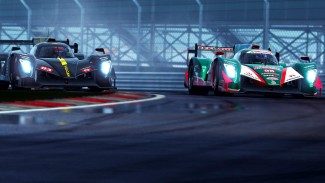 Project Cars represents a graphical workout in its vanilla gaming form and that translates to VR. The game is one of the few early VR titles which allows the user to customise at the same levels as a standard PC game. The VR defaults however are pretty ugly, with heavy aliasing evident and not much in the way of texture detail or indeed lighting fidelity. Again, in the interests of testing the VR rendering mettle of these cards, we maxed out almost all ‘Performance’ tab settings available, and only disabled or dialled back the distracting ‘Visual FX’ such as Lens Flare. We then tested 3 passes on each GPU with successively greater levels of anti-aliasing, from No AA to DS4X right up to DS9X – each clearly more taxing than the last.
Project Cars represents a graphical workout in its vanilla gaming form and that translates to VR. The game is one of the few early VR titles which allows the user to customise at the same levels as a standard PC game. The VR defaults however are pretty ugly, with heavy aliasing evident and not much in the way of texture detail or indeed lighting fidelity. Again, in the interests of testing the VR rendering mettle of these cards, we maxed out almost all ‘Performance’ tab settings available, and only disabled or dialled back the distracting ‘Visual FX’ such as Lens Flare. We then tested 3 passes on each GPU with successively greater levels of anti-aliasing, from No AA to DS4X right up to DS9X – each clearly more taxing than the last.
With the Oculus Rift headset positioned in a marked position on a desk in sight of the Oculus sensor, angled such that the view captured the majority of the road ahead. We then ran a fixed, one lap Solo race, with 19 competitors at Oulton Park ‘Fosters’, using the monitors mirror view to steer the car.
First up, we ran with no anti-aliasing. Even with most graphical options at their highest, in VR the resulting aliasing was extremely distracting using these settings. Nevertheless, Project Cars represented a significant VR challenge with both the GTX 1080 and 980Ti pushing high GPU usage levels. Despite the large troughs in performance for both cards (mainly when all cars are bunched up in game), stuttering was not an issue, fluidity was affected until the 2nd half of the lap, with slight ghosting on opponent cars. All in all, the experience on both cars was far better than the below graph might lead you to believe.
Next, the same run with DS4X AA engaged and a much improved image. With jaggies reduced (although still evident) it’s easier to focus on the environment although the horizon was still ultimately a blocky mess. As for in-headset performance, the 1080 provided the more fluid experience although neither card was able to maintain a rock solid 90FPS. Surprisingly, considering the variation of frame rates, there was no stutter evident, but movement appeared far less fluid on the 980Ti with a distracting subtle ghosting effect around moving objects.
By the time we reach maximum AA settings at DS9X, the 980Ti is struggling to maintain half of the required 90FPS frame rate. The GTX 1080 is also showing signs of strain but the resulting gameplay inside the VR headset is now refreshingly free of aliasing and in fact could be startlingly immersive. Again, Oculus are sprinkling their magic pixie dust, with the low frame rates on both cards still resulting in a playable, if less than ideally fluid experience whilst in the Rift. For those with strong VR legs however, this high fidelity rendering option does provide a striking, presence inducing image on occasion.
Chronos – Gunfire Games
 Chronos, with it’s static camera based viewpoint is another title you wouldn’t necessarily associate with pushing performance boundaries, but it’s a beautiful game and its opening cinematic is reasonably taxing – especially when you push the in game settings to ‘Epic’ across the board, that includes an increase of overall pixel density. With all that said, Chronos is clearly a very well optimised game. Even in this maxed-out configuration, neither card faltered rendering the opening sequence. As with previous benchmarks, each run was performed with the Rift positioned on a desk in view of the Oculus sensor, angled to capture as much important detail in the scene as possible.
Chronos, with it’s static camera based viewpoint is another title you wouldn’t necessarily associate with pushing performance boundaries, but it’s a beautiful game and its opening cinematic is reasonably taxing – especially when you push the in game settings to ‘Epic’ across the board, that includes an increase of overall pixel density. With all that said, Chronos is clearly a very well optimised game. Even in this maxed-out configuration, neither card faltered rendering the opening sequence. As with previous benchmarks, each run was performed with the Rift positioned on a desk in view of the Oculus sensor, angled to capture as much important detail in the scene as possible.
Both the GTX 1080 and 980 Ti provided a stutter free user experience overall and that’s born out by the rock solid 90+ FPS figures seen below.
However, looking at the GPU usage gives you an insight into just how much more headroom the GTX 1080 has compared to its older brother. It’s not an insignificant difference, with the 1080 barely passing 60% and the 980 Ti clearly sailing north of 80% during the more demanding moments of the sequence, most notably when dynamic lights were at maximum.
Conclusion
The GTX 1080 is here and it’s the most powerful single card Nvidia have produced yet. Raw rendering performance gains over the established Maxwell-based GTX 980Ti, whilst not epoch making, are significant – especially in our DirectX 12 benchmarks. In 2D applications the card can push high resolution, super-wide gaming admirably and when it comes to VR gaming, gives you some high quality options that are perhaps just out of reach of the 980Ti’s capabilities.
All of this is at stock frequencies too. As this new Pascal 16nm GPU is extremely efficient (on load temperatures of around 55-65 degrees centigrade or less) mean this card will likely provide a tasty target for overclockers. A test version of EVGA’s Precision X tuning tool turned up too late to include in this article, but the card was easily able to sustain a 200MHz base overclock with some voltage tweaks and I suspect it’s capable of much more.
As for those claimed fantastical VR performance gains, they have to be treated as largely theoretical for now. Pascal does introduce a radical, hardware assisted technology in the form of Simultaneous Multi-Projection, a parent technology which powers many VR relevant functions such as Multi-Res shading and Lens Matched Shading and all form part of the recently re-branded VRWorks suite of APIs. We’ll dive into more detail on some of these technologies imminently. But the point we need to make in the mean time is that, whilst all of the above could bring huge performance wins for virtual reality applications, they all require software to be coded to support them and, by definition are Pascal and Nvidia specific. And whilst Nvidia are working on wooing VR developers to adopt VRWorks right now, those performance benefits may take a little while to surface in the real world.
Owners of GTX 980’s will see a substantial uplift in performance should they choose to upgrade and those 980Ti owners with deep pockets who are willing to dabble in overclocking will also see very worthwhile benefits too.
If your focus is purely VR however, the upgrade argument is perhaps less compelling at this stage. With application developers judiciously targeting performance well below the capabilities of the GTX 1080 for very good reasons, it’s hard to see the need for 1080 levels of raw grunt for a little while. However, if you do upgrade, you will find yourself with the performance headroom to maximise visual fidelity in VR for some titles right now and potentially more down the line.
Disclosure: Nvidia paid for travel and accommodation for one Road to VR correspondent to attend an event where information for this article was gathered. Nvidia also provided Road to VR with a GTX 1080 GPU for review.

